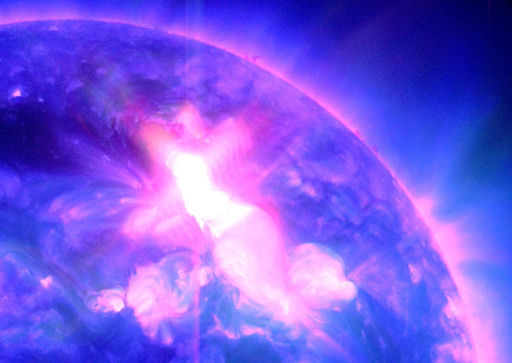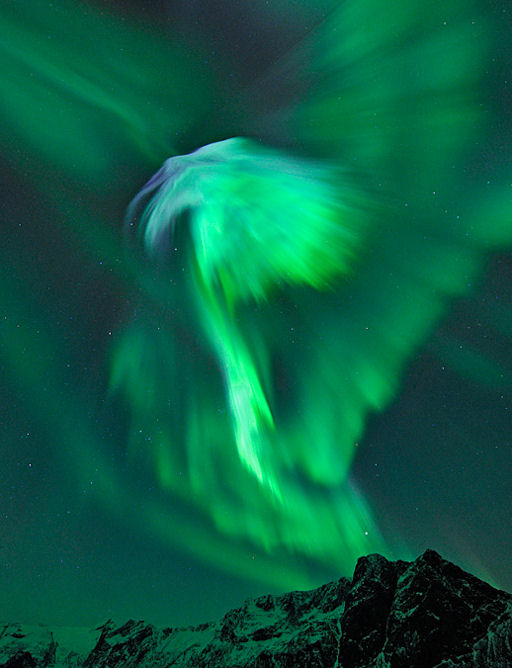ALMOST-X FLARE AND CME: This morning, Jan. 23rd around 0359 UT, big sunspot 1402 erupted, producing a long-duration M9-class solar flare. The explosion's M9-ranking puts it on the threshold of being an X-flare, the most powerful kind. NASA's Solar Dynamics Observatory captured the flare's extreme ultraviolet flash:
The Solar and Heliosphere Observatory (SOHO) and the STEREO-Behind spacecraft have both detected a CME rapidly emerging from the blast site. Analysts at the Goddard Space Weather Lab estimate a velocity of 2200 km. There is little doubt that the cloud is heading in the general direction of Earth. A preliminary inspection of SOHO/STEREO imagery suggests that the CME will deliver a strong glancing blow to Earth's magnetic field on Jan. 24-25 as it sails mostly north of our planet. Stay tuned for updates.Solar flare alerts: text, voice.
JAN. 22ND CME IMPACT: Arriving a little later than expected, a coronal mass ejection (CME) hit Earth's magnetic field at 0617 UT on Jan. 22nd. According to analysts at the Goddard Space Weather Lab, the CME strongly compressed Earth's magnetic field and briefly exposed satellites in geosynchronous orbit to solar wind plasma. For the next 24 hours, Earth's magnetic field reverberated from the impact, stirring bright auroras around the Arctic Circle. Bjørn Jørgensen observed this display from Tromsø, Norway:
"This was amazing," he says. "It was a wonderful experience to see these stunning auroras."
NOAA forecasters estimate a 10% - 25% chance of continued geomagnetic storms tonight as effects from the CME impact subside. The odds will increase again on Jan. 24-25 as a new CME (from today's M9-clare) approaches Earth. High-latitude sky watchers should remain alert for auroras. Aurora alerts: text, voice.

![]()
Solar wind
speed: 290.5 km/sec
density: 3.5 protons/cm3
explanation | more data
Updated: Today at 1414 UT
![]()
X-ray Solar Flares
6-hr max: C2 0823 UT Jan23
24-hr: M8 0359 UT Jan23
explanation | more data
Updated: Today at: 1400 UT
![]()
![]()
![]()
Daily Sun: 23 Jan 12
![]()
![]()
Sunspots 1401 and 1402 pose a threat for M-class solar flares. Credit: SDO/HMI
![]()
![]()
![]()
Sunspot number: 103
What is the sunspot number?
Updated 22 Jan 2012
Spotless Days
Current Stretch: 0 days
2012 total: 0 days (0%)
2011 total: 2 days (<1%)
2010 total: 51 days (14%)
2009 total: 260 days (71%)
Since 2004: 821 days
Typical Solar Min: 486 days
Updated 22 Jan 2012
The Radio Sun
10.7 cm flux: 141 sfu
explanation | more data
Updated 22 Jan 2012
![]()
![]()
![]()
Current Auroral Oval:
![]()
Switch to: Europe, USA, New Zealand, Antarctica
Credit: NOAA/POES
![]()
![]()
![]()
Planetary K-index
Now: Kp= 1 quiet
24-hr max: Kp= 5 storm
explanation | more data
![]()
Interplanetary Mag. Field
Btotal: 4.7 nT
Bz: 4.3 nT north
explanation | more data
Updated: Today at 1417 UT
![]()
![]()
![]()
Coronal Holes: 23 Jan 12
![]()
![]()
Solar wind flowing from the indicated coronal hole should reach Earth on Jan. 27-28. Credit: SDO/AIA.






